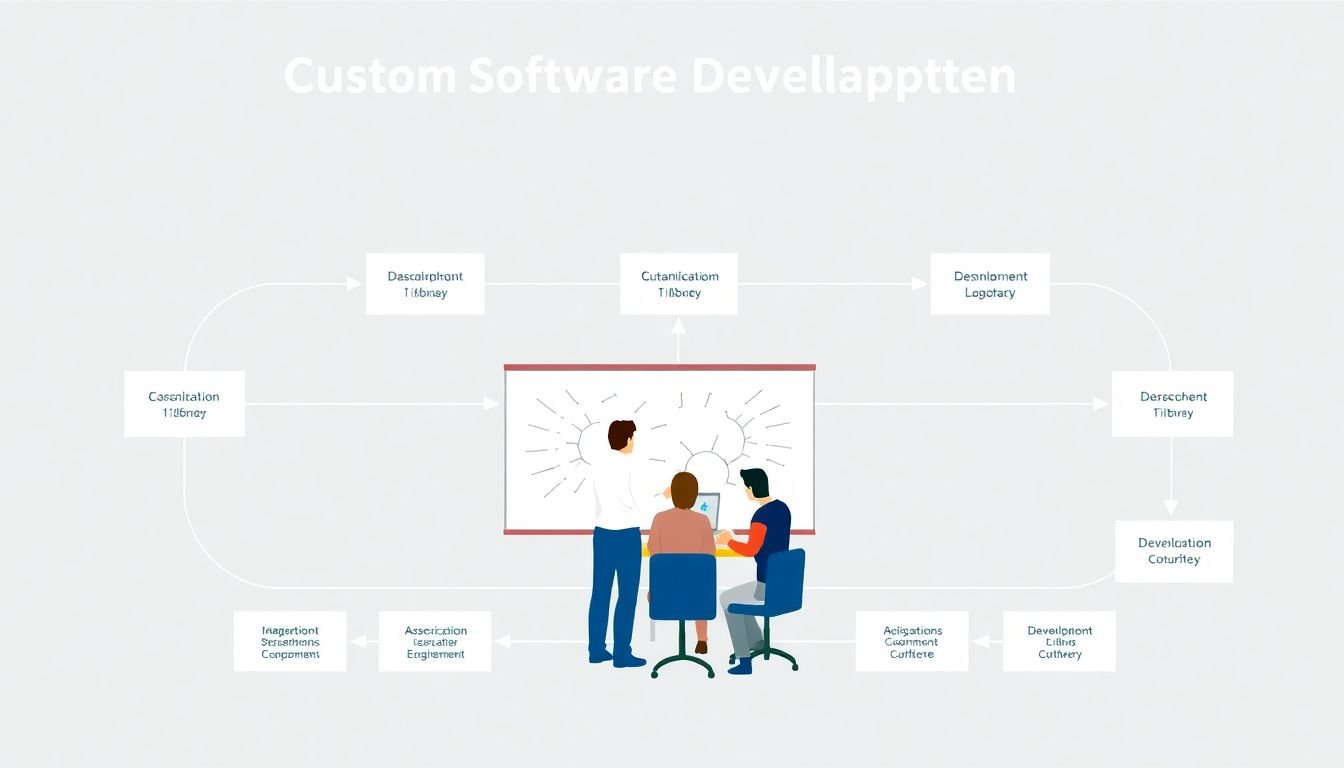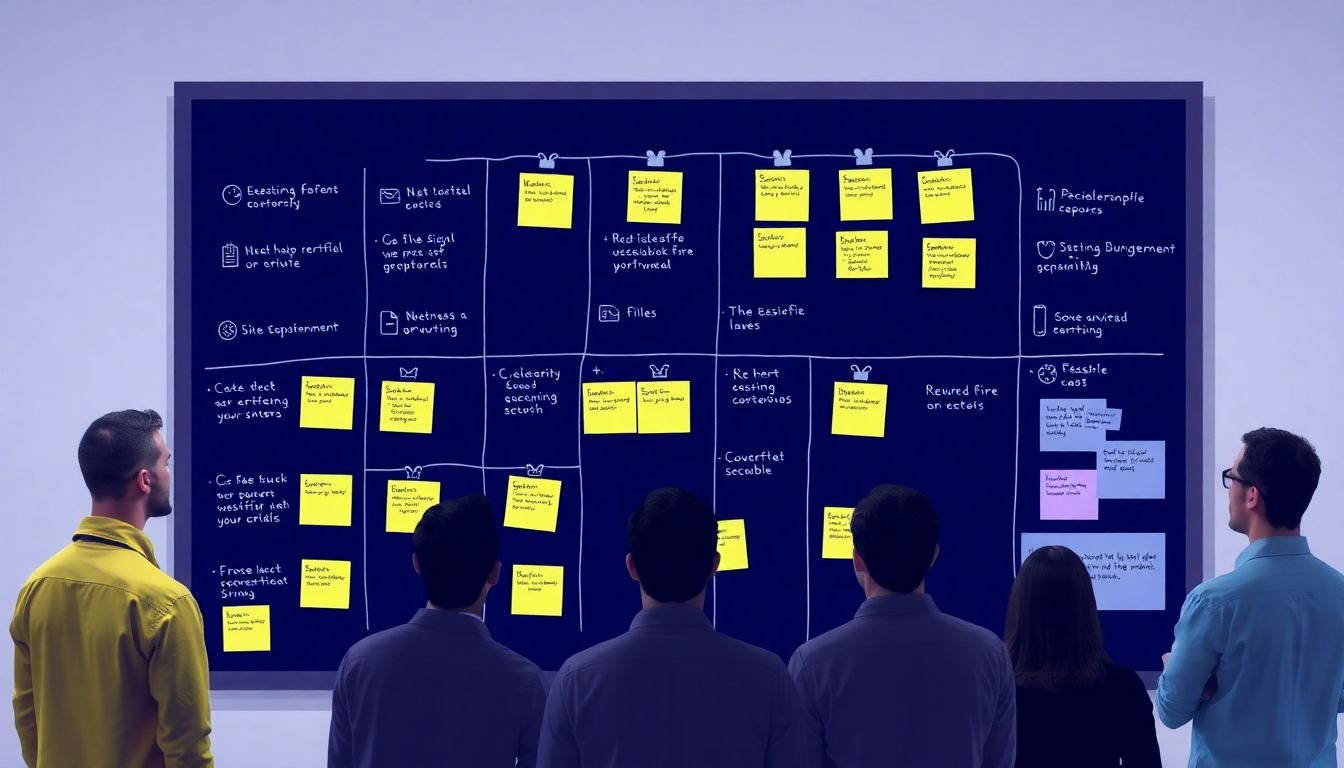
Table of Contents
In the dynamic landscape of today’s business world, one size certainly does not fit all. As a business owner or decision-maker, have you ever found yourself wishing for a technological solution that ticks all the boxes, but off-the-shelf software just doesn’t cut it? You’re not alone. Welcome to the realm of custom software solutions, where technology is tailored to fit your unique business needs like a glove.
Did you know that by 2023, the global custom software development market is expected to reach a staggering $120.5 billion, growing at a CAGR of 10.7% during the forecast period (2018-2023)? This exponential growth is a testament to the increasing demand for bespoke technology that can drive business growth, streamline operations, and provide a competitive edge.
Now, you might be wondering, ‘What exactly are custom software solutions, and how can they benefit my business?’ Great question! In essence, custom software is designed and developed from scratch to meet the specific needs and goals of your business. It’s like having a personal tech architect who understands your business intricacies and crafts a digital blueprint that supports your unique processes and workflows.
So, what can you expect to gain from this article? Well, we’re glad you asked! In the following sections, we promise to delve into the world of custom software solutions, exploring their benefits, the development process, and real-life examples of businesses that have transformed their operations with tailored technology. By the end of this read, you’ll have a clear understanding of how custom software can address your business challenges and drive growth. So, buckle up and get ready to explore the exciting possibilities that lie at the intersection of technology and your unique business needs.
Harnessing the Power of Bespoke Technology for Your Business
In the dynamic landscape of modern business, technology is not merely a tool, but a strategic partner that can propel your enterprise to unprecedented heights. Imagine having a technological ecosystem tailored to your business, as unique as your fingerprint, designed to optimize your processes, enhance your customer experiences, and drive your growth. This is the power of bespoke technology. It’s like having a personal trainer for your business, understanding your specific needs, pushing you to excel, and celebrating your victories with you. From streamlined operations to innovative products, from data-driven insights to secure infrastructure, bespoke technology is your secret weapon for outpacing the competition. It’s not just about having the latest gadgets or software; it’s about leveraging technology to tell your business’s story in a way that resonates with your audience and sets you apart. So, why settle for off-the-rack solutions when you can have technology that’s custom-made for your business? Let’s embark on this transformative journey together, where every line of code is a step towards your business’s unique greatness.

The Need for Custom Software in Business
In the dynamic world of business, one size often does not fit all. Off-the-shelf software, while offering convenience and affordability, can present significant limitations. These solutions are designed to cater to the broadest range of users, which can lead to a lack of tailored features that align with your business’s unique processes and workflows. They may not integrate seamlessly with your existing systems, leading to inefficiencies and potential data silos.
The need for custom software arises from this very gap. Custom software solutions are designed with your business’s specific needs in mind. They can adapt to your unique processes, workflows, and data structures, providing a seamless integration that enhances productivity and efficiency.
Consider the following advantages of custom software:
- Tailored Functionality: Custom software can be designed to perform tasks exactly as you need them to, streamlining your workflows and reducing manual effort.
- Scalability: As your business grows, custom software can grow with it. It can be scaled up or down to meet your changing needs.
- Competitive Edge: By leveraging technology that is uniquely yours, you can gain a competitive advantage. Custom software can help you innovate, differentiate, and stay ahead of the curve.
- Security and Compliance: Custom software can be designed with robust security features and to comply with industry-specific regulations, protecting your data and your business.
In essence, custom software is not just a tool, but a strategic investment that can drive business growth and success. It’s about more than just software; it’s about understanding your business, your processes, and your goals, and using technology to help you achieve them.

Understanding Your Business Needs
Embarking on a journey to develop custom software for your business is an exciting venture, but it’s crucial to pause and take a step back before diving into the technical aspects. The first, and perhaps the most critical, step is to gain a thorough understanding of your business’s processes, goals, and challenges. This might seem like an obvious starting point, but it’s astonishing how often this phase is rushed or overlooked, leading to software that doesn’t quite hit the mark.
Imagine you’re a chef about to cook a complex dish. You wouldn’t start chopping ingredients without first understanding the recipe, would you? Similarly, understanding your business needs is like understanding the recipe. It’s the blueprint that guides the entire software development process.
Let’s break down why this understanding is so important.
- Processes: Understanding your business processes helps in identifying areas where software can streamline workflows, improve efficiency, and reduce manual effort. It ensures that the software is designed to fit seamlessly into your existing operations, rather than disrupting them.
- Goals: Knowing your business goals helps in aligning the software’s features and functionalities with your long-term objectives. Whether it’s increasing sales, improving customer satisfaction, or expanding into new markets, the software should be a tool that propels you towards these goals.
- Challenges: Acknowledging and addressing your business challenges helps in creating software that solves real problems. It could be managing data more effectively, improving communication among teams, or enhancing security. By understanding these challenges, the software can be tailored to overcome them.
In essence, understanding your business needs is about creating software that truly meets your requirements. It’s about building a tool that doesn’t just look good on paper, but one that understands your business, speaks its language, and works tirelessly to help it grow. So, take the time to understand your business needs. It’s the secret ingredient that turns good software into great software.

The Custom Software Development Lifecycle
The Custom Software Development Lifecycle (SDLC) is a systematic process that ensures the creation of high-quality, efficient, and tailored software solutions. It’s a journey that begins with understanding the business’s unique needs and culminates in the deployment and maintenance of the software. Let’s delve into the key stages of this process.
1. Requirement Gathering and Analysis:
The SDLC kicks off with a deep dive into the business’s objectives, pain points, and goals. This stage involves extensive communication with stakeholders to understand the software’s purpose, features, and functionality. The outcome is a comprehensive requirements document that serves as the blueprint for the entire project.
2. Design:
With the requirements in hand, the development team moves on to the design phase. This stage involves creating detailed system and software design documents that outline the architecture, database schema, and user interface. The design should be modular, scalable, and secure, ensuring it aligns with the business’s long-term goals.
3. Implementation or Coding:
The design is then translated into code. This stage involves writing clean, efficient, and maintainable code. It’s crucial to follow best practices and coding standards to ensure the software’s performance, security, and scalability. The code is typically written in iterations, with each iteration focusing on a specific feature or module.
4. Testing:
Once the coding is complete, the software moves into the testing phase. This stage involves a series of tests, including unit testing, integration testing, system testing, and user acceptance testing. The goal is to identify and fix bugs, ensure the software meets the requirements, and validate its performance and functionality.
5. Deployment:
After successful testing, the software is ready for deployment. This stage involves releasing the software into the production environment. The deployment should be smooth, with minimal downtime and no disruption to the business’s operations. It’s also crucial to have a rollback plan in case something goes wrong.
6. Maintenance:
The SDLC doesn’t end with deployment. Software is a living entity that requires regular updates, bug fixes, and enhancements. The maintenance stage involves addressing user feedback, fixing bugs, and adding new features. It’s an ongoing process that ensures the software continues to meet the business’s evolving needs.
Each stage of the SDLC plays a critical role in ensuring the software meets the business’s unique needs. It’s a collaborative process that involves continuous communication, feedback, and improvement.

Technologies Used in Custom Software Development
In the dynamic realm of custom software development, the choice of technologies, programming languages, and tools is as varied as the businesses and projects they serve. This selection process is akin to an artist choosing their palette; each tool brings unique capabilities that can enhance or limit the final product. Let’s delve into the vibrant spectrum of technologies that make up this digital artist’s toolkit.
The first decision point often revolves around the programming language. Here, we have a plethora of options, each with its own strengths. For instance, Java is robust and secure, making it a popular choice for enterprise-level applications. Python, on the other hand, is renowned for its simplicity and readability, often used in data analysis and machine learning. JavaScript, the backbone of web development, enables interactive and dynamic web applications.
Frameworks and libraries are the next layer of decision-making. They provide pre-built components that accelerate development, such as React for JavaScript, Django for Python, or Spring for Java. The choice depends on the project’s specific needs, the team’s expertise, and the community support for the framework.
Databases are another critical aspect. Relational databases like MySQL and PostgreSQL store data in tables, while NoSQL databases like MongoDB and Cassandra offer more flexibility, making them ideal for large-scale, unstructured data. The choice depends on the data’s nature, the required query complexity, and the scalability needs.
Version control systems like Git ensure that changes to the codebase are tracked and managed effectively. They facilitate collaboration among developers and help maintain a clean, organized codebase.
Finally, the choice of development methodologies can also impact the technology stack. Agile development, for instance, often uses lightweight tools and encourages iterative development. Waterfall methodologies, on the other hand, may prefer more structured, heavyweight tools.
In conclusion, the choice of technology in custom software development is a complex interplay of business needs, project requirements, team expertise, and community support. It’s a decision that can significantly impact the project’s timeline, cost, and ultimately, its success. Therefore, it’s crucial to approach this decision with careful consideration and a deep understanding of the project’s unique needs.

The Role of Agile Methodologies in Custom Software Development
In the dynamic landscape of custom software development, Agile methodologies have emerged as a game-changer, offering unparalleled flexibility, speed, and customer satisfaction. At the heart of these methodologies lie Scrum and Kanban, two powerful frameworks that adapt to unique business needs like a chameleon changes its color. Let’s dive into how these methodologies work their magic.
Scrum, for instance, is like a well-oiled machine, with clear roles and ceremonies that keep the development process humming. The Scrum team, consisting of a Product Owner, Scrum Master, and Development Team, works in sprints, typically lasting two to four weeks. Each sprint begins with a sprint planning session, where the team selects what to do in the upcoming sprint and defines how it will be done. The sprint culminates in a sprint review, where the team demonstrates the new functionality to stakeholders, and a sprint retrospective, where the team reflects on the past sprint and identifies opportunities for improvement. This iterative approach allows for continuous feedback and adaptation, ensuring that the software developed aligns with the customer’s evolving needs.
Kanban, on the other hand, is a visual system that focuses on limiting work in progress and maximizing efficiency. It uses a Kanban board, a visual representation of the workflow, to manage the development process. The board is divided into columns, each representing a stage of the workflow, from ‘To Do’ to ‘Done’. Work items, typically represented by cards, move through the columns as they progress. The key to Kanban’s success is its commitment to limiting work in progress, ensuring that the team doesn’t bite off more than it can chew and maintaining a steady, sustainable pace. This approach minimizes multitasking, reduces context switching, and increases focus, leading to faster delivery times.
Both Scrum and Kanban excel in their own ways, but they can also be used together, a practice known as ‘Scrumban’. This hybrid approach combines the iterative nature of Scrum with the continuous flow of Kanban, offering the best of both worlds. Whether used independently or together, these methodologies demonstrate a remarkable ability to adapt to unique business needs. They allow for changes in requirements mid-project, ensuring that the software developed is not only functional but also valuable to the customer. In essence, Agile methodologies are not just about developing software; they are about developing software that truly matters.

Ensuring Security and Compliance in Custom Software
In the digital age, the importance of security and compliance in custom software development cannot be overstated. Businesses today rely heavily on software to manage their operations, store sensitive data, and interact with customers. Therefore, ensuring the security and compliance of custom software is not just a technical requirement, but a critical business necessity.
The process of addressing security and compliance begins right from the inception of the software development lifecycle. The first step involves identifying potential threats and vulnerabilities. This is typically done through risk assessments and threat modeling exercises. These help in understanding the potential risks and designing countermeasures to mitigate them.
Next, secure coding practices are implemented throughout the development process. This includes using secure coding standards, regular code reviews, and static application security testing (SAST) tools. These practices help in identifying and fixing security vulnerabilities early in the development cycle.
Access controls are also implemented to ensure that only authorized individuals can access the software and its data. This is typically done through user authentication and authorization mechanisms. Additionally, the principle of least privilege is followed, which means that users are given the minimum levels of access necessary to perform their job functions.
Regular security testing is also conducted to identify and fix any security vulnerabilities that may have been introduced during the development process. This includes dynamic application security testing (DAST) and penetration testing.
In terms of compliance, the software is developed to adhere to relevant industry standards and regulations. This includes data protection regulations like GDPR, HIPAA for healthcare, and PCI-DSS for payment card data. Compliance is ensured through regular audits and by maintaining detailed documentation of the development process.
Moreover, the software is designed to be resilient and able to withstand attacks. This includes implementing secure backups, disaster recovery plans, and business continuity plans.
In conclusion, ensuring security and compliance in custom software development is a continuous process that involves multiple steps and requires a collaborative effort from all stakeholders. It is not just about writing secure code, but also about designing secure systems, implementing secure processes, and regularly testing and auditing the software. By doing so, businesses can protect their data, ensure regulatory compliance, and build trust with their customers.

The Cost-Effectiveness of Custom Software Solutions
In the dynamic landscape of business technology, the cost-effectiveness of custom software solutions often outweighs that of off-the-shelf software. While the initial investment in custom software might seem daunting, a deeper dive reveals a plethora of benefits that translate into significant long-term savings and increased efficiency.
The primary advantage lies in the tailored nature of custom software. Unlike off-the-shelf solutions that often require businesses to adapt their processes to fit the software, custom software is designed to fit the business like a glove. This means that every feature, every button, every line of code is there because it serves a specific purpose in your business operations. This level of specificity can lead to substantial operational cost savings by streamlining workflows and reducing human error.
Moreover, custom software can help businesses increase efficiency by automating repetitive tasks. This not only saves time but also reduces the risk of errors that can occur when tasks are performed manually. For instance, a custom software solution could automate inventory management, order processing, or customer relationship management, freeing up employees to focus on more complex tasks that require human judgment and creativity.
Furthermore, custom software can provide a high return on investment (ROI) by offering features that give businesses a competitive edge. These could be unique features that set your business apart from competitors or advanced analytics tools that provide valuable insights into customer behavior and market trends. By investing in custom software, businesses can gain a competitive advantage that can translate into increased market share and revenue.
In conclusion, while the upfront cost of custom software solutions might be higher than off-the-shelf software, the long-term benefits in terms of operational cost savings, increased efficiency, and high ROI make it a cost-effective solution for many businesses. It’s a case of investing a little more upfront to save and earn a lot more in the long run.

Maintaining and Updating Custom Software
In the dynamic landscape of modern business, maintaining and updating custom software is not just an option, but a necessity. Custom software, tailored to meet specific business needs, is a significant investment that can provide a competitive edge. However, like any tool, it requires upkeep to remain effective and relevant. This is where the role of the development team comes into play.
The business world is in a state of constant flux, with needs and priorities shifting over time. New regulations may emerge, customer preferences may evolve, or new opportunities may present themselves. Custom software, designed to adapt to these changes, is a flexible asset that can grow with your business. Regular maintenance and updates ensure that your software remains responsive to these shifting demands.
Technological advancements also play a crucial role in this equation. New programming languages, frameworks, and tools emerge regularly, promising improved performance, enhanced security, and innovative features. By keeping your custom software up-to-date, you can leverage these advancements to improve efficiency, reduce costs, and stay ahead of the curve.
The development team is the backbone of this process. They are responsible for understanding the evolving needs of the business and translating them into software solutions. Here’s how they contribute to maintaining and updating custom software:
- Ongoing Support: They provide continuous support to address any issues that may arise, ensuring minimal downtime and maximum productivity.
- Regular Updates: They schedule and implement regular updates to incorporate new features, improve performance, and patch security vulnerabilities.
- Adaptive Design: They design the software to be adaptable, allowing it to evolve with the business and incorporate new technologies.
- Training and Knowledge Sharing: They provide training to users to ensure they can make the most of the software’s features and keep them informed about updates and new functionalities.
In essence, maintaining and updating custom software is not just about keeping the lights on; it’s about driving business growth, enhancing competitiveness, and future-proofing your operations. The development team, with their technical expertise and understanding of your business, are your partners in this journey, ensuring your software remains a powerful tool for success.

Case Studies: Custom Software Solutions in Action
In the dynamic landscape of modern business, off-the-shelf software often falls short in catering to the unique needs and processes of an organization. This is where custom software solutions shine, tailoring technology to fit like a glove. Let’s delve into two compelling case studies that illustrate the power of bespoke software.
Case Study 1: Streamlining Logistics for GreenLeaf Delivery
GreenLeaf Delivery, a burgeoning eco-friendly courier service, faced a logistical nightmare. Their manual routing and tracking system was inefficient, leading to delayed deliveries and dissatisfied clients. They needed a solution that could optimize routes, track packages in real-time, and provide seamless communication with customers.
Our team developed a custom software suite, ‘GreenRoute’, that integrated GPS tracking, dynamic route optimization, and automated customer notifications. Here’s how it worked:
- GPS tracking provided real-time location data, enabling accurate delivery tracking and proof of service.
- An advanced algorithm optimized routes based on traffic, package size, and delivery sequence, reducing fuel consumption and delivery times.
- Automated notifications kept customers informed about their package’s status, enhancing their experience.
The results were nothing short of transformative. GreenLeaf saw a 35% reduction in delivery times, a 25% decrease in fuel costs, and a significant boost in customer satisfaction.
Case Study 2: Enhancing Patient Care for MediTech Clinic
MediTech Clinic, a progressive healthcare provider, struggled with managing patient records and appointments using disparate systems. They needed a unified platform that could handle electronic health records (EHR), appointment scheduling, and patient communication.
We created ‘MediConnect’, a comprehensive, HIPAA-compliant software solution. It integrated EHR, appointment scheduling, patient portals, and secure messaging. Here’s how it revolutionized their operations:
- EHR integration allowed for centralized, secure patient record-keeping, improving care coordination.
- An intuitive appointment scheduling system reduced no-shows by 20% and streamlined staff workflows.
- Patient portals and secure messaging enhanced patient engagement and satisfaction.
MediTech Clinic witnessed improved patient outcomes, increased staff productivity, and a 15% growth in patient satisfaction scores. These case studies underscore the power of custom software solutions in driving business success. By understanding and addressing the unique challenges of each organization, we’ve helped them leapfrog ahead in their respective industries.
FAQ
What exactly are custom software solutions?
Why should my business consider bespoke technology?
How does the process of developing custom software begin?
- in-depth consultations
- assessment of your current tech infrastructure
- identification of areas for improvement
and the creation of a detailed project plan.
What technologies are used in custom software development?
- programming languages like Python, Java, or .NET
- databases such as MySQL, PostgreSQL, or MongoDB
- cloud platforms like AWS, Azure, or Google Cloud
- front-end technologies like React, Angular, or Vue.js
among others.
How long does it take to develop custom software?
What happens after the software is developed?
- regular updates and maintenance
- security patches
- feature enhancements or additions
to keep the software relevant and effective.
How much does custom software development cost?
Can custom software be integrated with existing systems?
What if my business doesn’t have an in-house tech team?
How can I ensure the success of my custom software project?
- clearly define your project goals and requirements
- choose a reputable development partner
- maintain open lines of communication throughout the project
- be involved in the testing and feedback process
- have a plan for post-launch support and updates
to ensure the software continues to meet your business needs.